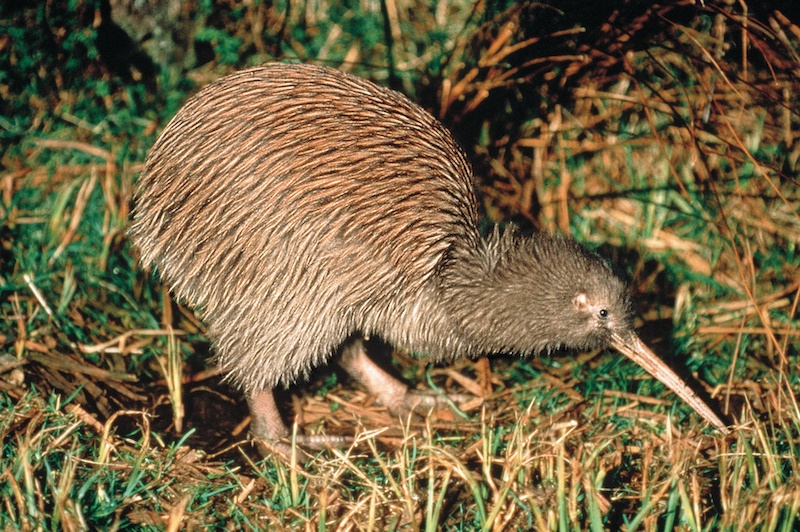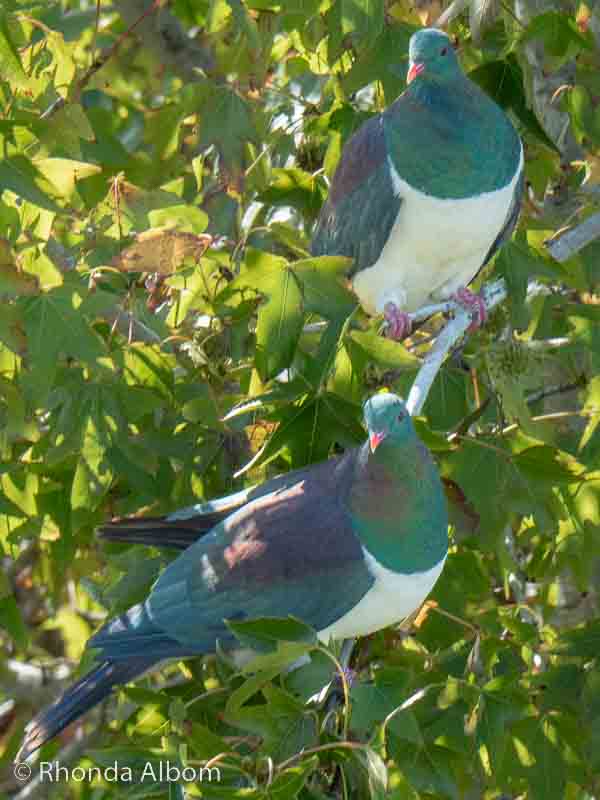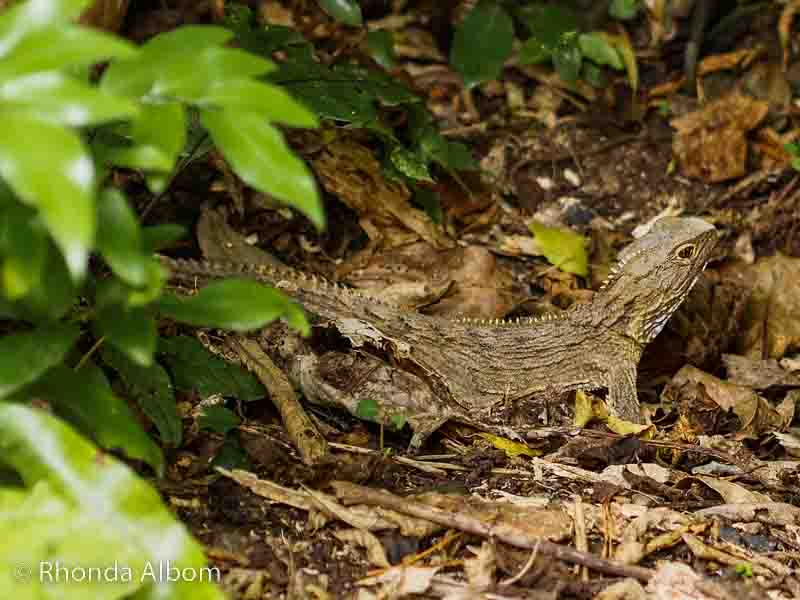New Zealand is stunning landscapes and picturesque views, and unique and fascinating wildlife. Most people are familiar with the kiwi bird, but there are so many other unique animals in New Zealand.
From the endangered Hector’s dolphin to the ancient reptile, the tuatara, below, we feature 20 unique animals in New Zealand that you’ve probably never heard of.
We love spotting New Zealand wildlife, have the patience to wait quietly, and have seen most of these unique animals in the wild. Some of them were random spottings; others had ridiculous stories. It’s all below.
Importantly, many of these creatures are native and were present in the country before the arrival of human settlers. And, possibly as a result of our isolation from other land masses, a significant proportion of these animals are endemic, which means they are unique to New Zealand and found nowhere else in the world.
Due to habitat loss and predation by non-native species, some of New Zealand’s native wildlife is currently endangered, making conservation efforts vital to their survival.
20 unique New Zealand animals
- Flightless birds: Kiwi, Yellow-eyed penguins, Fiordland Crested penguins, Little Blue penguins, Takahē
- Other birds: Morepork, New Zealand wood pigeon, Kea, Tui, New Zealand falcon
- Reptiles: Northland green geckos, tuatara
- Frogs: Archey’s frog
- Marine mammals: Maui dolphins and Hector’s dolphins, NZ Fur Seal, NZ Sea Lion
- Mammals: Lesser short-tailed bat
- Insects: Giant weta, glow worms
- Marsupials: Wallaby
Birds make up a large portion of the unique animals in New Zealand
New Zealand is home to a variety of unique native bird species, many of which are only in the country.
Kiwi bird



A national treasure and a New Zealand icon, the kiwi bird is a unique and fascinating native.
Personally, I find everything about them fascinating, from their tiny wings on a round flightless body covered in shaggy brown feathers to their distinctive long beaks. Nocturnal by nature, they are rarely seen in the wild, although they are commonly spotted on Stewart Island.
Their importance to the country is evident as their image appears on everything from currency to sports team logos.
Impressive conservation efforts have helped some of the species of kiwi thrive. They have brought them back to the mainland and released them in several well-protected parks. I am proud to say that Jeff was part of the ceremony that released Little Spotted kiwi at Shakespear Park many years ago.
Read next: Where to See Kiwi in New Zealand: Insider Guide to 27 Spots
Morepork / ruru


My recent and amazing encounter looking into the eyes of New Zealand’s adorable little native owl, the morepork / ruru is the inspiration for writing this today.
This curious bird perched on my arm stared back at me with its big, round eyes. It was an unforgettable moment as I felt a connection with this beautiful creature.
The morepork’s call sounds like “more pork” when they vocalise, making it even more endearing. It was a privilege to have this close encounter at Shaw’s Bird Park, and it made our day trip to Hamilton even more special.
Penguins



I know what you’re thinking; penguins are not unique to New Zealand. Some of them are. In particular, the Fiordland Crested penguin / tawaki and Yellow-eyed penguins / hoiho.
We have been fortunate to see all three species of penguins that nest on the mainland in the wild. If you don’t know where to look, check out this guide to where to see penguins in NZ.
- Yellow-eyed penguins / hoiho
We saw a yellow-eyed penguin up close and personal just beyond Katiki Point lighthouse on the South Island. This unique species, found only in New Zealand, is easily recognisable by the bright yellow band coming from its eyes. These penguins are rare, with only an estimated 4,000 in the wild. - Fiordland Crested penguin / tawaki
Similarly, we hiked out to Monroe Beach on the West Coast and waited quietly and patiently for about two hours before a Fiordland Crested penguin waddled up from the sea, crossed the beach and headed for the bush. - Little Blue pengiun / kororā
The third species found on the land, Little Blue, is the world’s smallest penguin species. A native, but not unique to New Zealand. Also known as fairy penguins, these adorable creatures with blue and white feathers stand about 25 cm tall. We have seen them in the wild many times, with my highlight watching a raft of them come home for the evening on the Otago Peninsula.
Takahē

At first glance, the takahē looked like a fat, colourful chicken to me. This flightless bird, once considered extinct, has made a remarkable comeback due to conservation efforts on the islands. Just about every time we head out to Tiritiri Matangi Island, we spot a resident takahē, and we have even seen her with a chick.
They are critically endangered and well protected. We have also been lucky to see takahē at Zealandia in Wellington and Orokonui Ecosanctuary just outside Dunedin.
New Zealand wood pigeon / kererū

The kererū, with its iridescent green and bronze feathers, stands out as a distinctive bird that you can commonly find in New Zealand’s native forested areas. In fact, we see the New Zealand wood pigeon / kererū perched on local trees all the time, yet they always make me smile.
I can’t help it. It’s their tiny heads on huge bodies that make them one of the unique animals in New Zealand.
Kea

New Zealand’s cheekiest bird is also the world’s only alpine parrot.
Although beautiful, especially in flight, the kea has a reputation for attempting to pick the rubber off the car window surrounds, and our car was no exception. Of course, we were too busy shooing it off to stop and take a photo; therefore, I took the photo of the one above at Orana Park in Christchurch.
While they are incredibly intelligent birds, their mischievous behaviour has earned them the title of “clown of the mountains”.
Tui

My favourite songbird, the tui, is endemic to New Zealand. With distinctive plumage of iridescent feathers shimmering in a range of greens, purples, and bronze, the bird’s most striking feature is a white tuft of feathers just below its head.
Tuis also have acrobatic abilities. They are important pollinators of New Zealand’s native flora. Rumour has it that they get drunk from the nectar of the flowers on the Kowhai tree.
New Zealand Falcon / kārearea

The New Zealand falcon / kārearea, found around the North Island, can also be spotted in some areas of the South Island. A medium-sized bird with a wingspan of up to one metre, they are graceful to watch fly.
These raptors demonstrate remarkable agility in the air, swooping and diving at high speeds to capture their prey. Although they actively hunt, habitat loss and human interference have endangered the New Zealand falcon.
Unique animals in New Zealand: Reptiles and frogs


- Northland green geckos
These geckos are endemic to New Zealand. They have large, triangular-shaped heads, slender bodies, and a striking green colour ranging from light lime green to a darker, almost forest green. Northland green geckos are arboreal. They live in trees, typically in the northern regions of New Zealand’s North Island. We believe we have seen them near Driving Creek Railroad in Coromandel. - Tuatara
During our last visit to Zealandia, I had the incredible opportunity to see a tuatara in the wild. An ancient reptile, tuatara has survived for more than 200 million years without major changes. In fact, many people refer to it as the only living relative of the dinosaur. Its spikey appearance and rough texture give it a prehistoric look, as does the “third eye” on top of its head, which it uses to regulate circadian rhythms - Archey’s frog
The smallest of four frogs endemic to New Zealand, and one that I have yet to see in the wild. However, I have seen one at the Auckland Zoo. This ground-dwelling frog may be the world’s rarest and most endangered amphibian.
Unique animals in New Zealand: Marine animals
Māui and Hector’s dolphins

- Hector’s dolphin
The world’s smallest and rarest marine dolphin species are typically found in shallow and turbid waters close to shore on the South Island. These dolphins are characterized by their distinctive black markings around their face and body, with a unique curved dorsal fin. The best way to see these fascinating creatures in their natural habitat is to take a dolphin-watching tour from the Banks Peninsula, Akaroa. - Māui dolphin
Also one of the smallest members of the dolphin family, the Māui dolphin has distinct grey, white, and black markings and significantly shorter snouts compared to other dolphins. Unfortunately, the Maui dolphin is currently an endangered species, and experts predict that less than 60 dolphins are left in the wild. We saw them in the wild in Curio Bay in the Catlins.
New Zealand fur seal / kekeno

Large and beautiful, there is nothing quite like coming around a corner and spotting a New Zealand fur seal basking on the rocks or a pup swimming at the shore. As a former volunteer in a marine mammal hospital, I have worked with many sea lions, yet the thrill of seeing them never goes away. It’s always an incredible experience to witness these amazing creatures in their natural habitat.
The New Zealand fur seal is a native species with sleek, black fur and big soulful eyes. We saw the New Zealand native photoed here about 30 minutes after we spotted the yellow-eyed penguins near the Katiki Point lighthouse. It was a great day.
New Zealand sea lion / whakahao

One endemic species that we have yet to see in the wild is the New Zealand sea lion, also known as whakahao. They are the rarest species of sea lion in the world with a total population of only 12,000 individuals.
These seals can be found primarily on the sub-Antarctic Auckland and Campbell Islands and on the south coast of Stewart Island.
They are one of the few species of marine mammals that breed on the New Zealand mainland. However, their breeding colonies are vulnerable to human disturbance and habitat destruction. The New Zealand Government has implemented conservation measures to protect these sea lions, including a fishing exclusion zone around their breeding sites. Despite these efforts, the New Zealand sea lion is still considered one of the most endangered marine mammals in the world.
Four more unique animals in New Zealand




Lesser short-tailed bat
Bats are the only native mammals in New Zealand (excluding marine mammals). Not really a fan, I am pleased to say I rarely see them. However, the native lesser short-tailed bat has earned its place on a list of unique New Zealand animals. Unfortunately, this species has become endangered due to habitat loss, predation, and disease, with only a few populations left.
Giant weta / wētāpunga
I’ll admit it, my first encounter with the world’s heaviest insect gave me a huge fright. After a few breaths, I took a closer look. At first, I thought it was just a big cricket, but upon closer inspection, I realized it was something entirely different. Its bulging eyes and hairy body made it seem like a creature from another world. Although they have been reintroduced in Shakespear park, the image was in the Waitakere ranges. Despite what I was told, I don’t believe it’s a giant weta, but rather a smaller variety. I also included a photo of a bunch of cave weta I also came upon unexpectedly, reacting quite similarly.
Wallaby
Wallabies ( look like small kangaroos ), are not New Zealand natives but were brought to Kawau Island by the former Prime Minister, Sir George Grey, in the late 1800s. Today, many people think they shouldn’t be here at all. History tells us that Grey also brought zebras and other animals that didn’t survive. But these marsupials have made their home on the island. Unfortunately, they move quickly, and by the time I spotted them, they were too far off to get a decent photo. But the memory is imprinted in my mind. I took the image above at the Auckland Zoo.
Glow worms
Arachnocampa luminosa (scientific name) is a fungus gnat in its larva stage. Endemic to New Zealand and parts of Australia, they are found in caves, tunnels, forested areas, and grottos. The light is functional, as it attracts other bugs and insects. We share dozens of both the North and South Islands spots to see glowworms in New Zealand here.
Report sick, injured or dead wildlife
If you come across sick, injured, or dead wildlife in New Zealand, it is important to take appropriate action while also keeping yourself safe.
Firstly, you should not disturb the animal or attempt to move it. Instead, report it to the Department of Conservation (DOC) as soon as possible. The DOC has a dedicated emergency hotline for such situations, which is available 24/7. Dial the free number 0800 DOC HOT (0800 362 468).
When reporting the situation, make sure to provide your name, location, and a brief description of the animal’s condition. Additionally, including your phone number can help the authorities reach you for further information or follow-up. It is crucial to report these sightings to ensure that the DOC can provide the necessary care and support to the affected wildlife.
Importance of conservation efforts for unique New Zealand animals
Conservation efforts are crucial to protecting the unique and diverse range of native animals found in New Zealand. The country is home to several iconic species threatened by habitat loss, predation, and other environmental pressures.
These animals play important roles in the ecosystem, acting as pollinators, seed dispersers, and controlling pest populations. Conservation efforts to protect their habitats, reduce threats from introduced predators, and reintroduce them into suitable areas can help prevent these animals from becoming extinct.
Conservation efforts are essential for maintaining the delicate balance of New Zealand’s environment and ensuring that future generations can enjoy its natural heritage.
You might also like:
Which of these New Zealand birds and animals have you seen?
Photo Credits:
All photos on this page are either shot by our team and watermarked as such or stock images from Depositphotos.


lisa
My goodness – even the pigeons are cuter in New Zealand! So many adorable birds to see!
Susan
I’m such a sucker for penguins but the Tui’s are pretty darn cute too! Makes me want to go back to New Zealand 🙂
Danae
This really makes me want to visit New-Zealand! The animals look so cute 🙂
Gabby Leopard
New Zealand has been on my bucket list for a long time so this was interesting to read. I can’t wait to see a penguin in real life!
Taylor
So many cool things to see in New Zealand! I’d love to see a wallaby even if they’re not indigenous.
Josy A
I totally agree with you about this! I LOVED seeing all the birds in NZ, especially the Tui and Kea. The Keas we saw had such strong, cheeky personalities! We didn’t see many reptiles, or even a weta, so I guess I need to go back 😉
Linda (LD Holland)
On our recent Antarctica cruise I was surprised to learn how many animals came from New Zealand and our onboard ornithologist talked a lot about the New Zealand flightless birds. Would be fun to see some of the ones he talked about. And yes your pics made me smile! But the dolphins and seals might be my favourites.
L. Diane Wolfe
Kiwis are cute. So are wallabies even if they aren’t native. I got to pet one at a local privately-owned zoo. He was SO friendly.
I assume you’ve seen the sea lions along the Oregon and Washington Coasts? They are everywhere!
Rhonda Albom
Oh yes. And, when I lived in San Francisco, I volunteered at a marine mammal rescue centre, so I saw them up close and personal too.
Melanie
I tried to see penguins on our trip to New Zealand, but we didn’t luck out. Hopefully next time! I could do without seeing the weta, though!
Alex+J.+Cavanaugh
The takahē is new to me.
How big is the weta?
Unique looking dolphins!
Rhonda Albom
The giant weta can be as big as your hand, but that one in the photo was probably just as big as my palm.